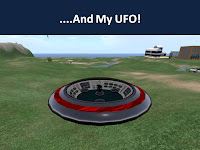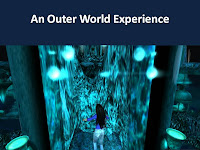The EduFaire was held late January 2009 in Second Life. The purpose was for educational organisations in Second Life to showcase their projects, tools, activities and sims. There were a range of sessions to attend and displays to explore. The following photos provide examples of some of the EduFaire sessions:
In the above photo, you can see five (5) presenters with posters in the background, a display board which works like a PowerPoint presentation and a Chat Log tool. The Chat Log is the box in the front, just left of centre, with names in red font hovering above it. These are the names of the participants giving permission for their typed chat to be recorded into a transcript for later perusal.
One of the presenters in the above photo, has rezzed (brought in-world) a tool which helps teaching records and processes to be communicated between the First and Second Worlds. This tool will be discussed in greater detail in a later post.
This aerial view (above) allows you to get a feel for the learning space setup and the avatars in attendance. The text hovering above the avatar heads are their names. This function can be turned off to reduce visual clutter. In the left bottom corner is part of the typed chat of this session. The box with the blue circles is a camera tool on the screen and not inworld.
Above, is a side view of avatars gathering for a session.
Overall, this 2009 EduFaire was an informative and successful event.




























